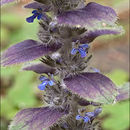en
names in breadcrumbs


Pyramidal bugle is a perennial, herbaceous plant growing from about 5 to 20cm (2 to 8in) tall. At the base there is a rosette of stalked leaves which are significantly larger than the stem leaves. The stiff upright hairy stem is square and bears simple leaves growing in opposite pairs. They are ovate, hairy above and below and have a slightly wavy edge. The inflorescence has leaf-like bracts subtending the individual flowers. The bracts gradually get smaller towards the tip of the inflorescence, are always longer than the flowers and the upper ones are often tinged purple. The inflorescence forms a pyramid-shaped terminal spike and is formed of axillary whorls. The calyx of each flower is five-lobed, the bluish-violet corolla has a long tube and is fused, with two lips. The upper lip is very short and the lower lip is three-lobed. There are four stamens, two long and two short. The gynoecium is formed of two fused carpels and the fruit is a four-chambered schizocarp. The hermaphrodite flowers are zygomorphic. The flowers produce nectar to attract pollinators which are bumblebees and butterflies.[2]
The flowering time extends from June to August. The chromosome number is 2n = 32
EcologyThe bracts in the inflorescence form effective shelters for the flowers from rain, their red-violet color enhances the signal effect of the flowers. The shaggy hairiness of the calyx protects the flower against small, crawling insects. The nectar is additionally secured by a stiff, upturned hair ring.
DistributionRocky ground, very rare in Ireland.[3]Also found in Scotland and Westmorland in England.
OccurrenceThe pyramid bugle is native to in northern Europe and the Caucasus where it occurs at sea level in the British Isles, in the mountains of central and southern Europe, and in northern and western Scandinavia. It grows on almost neutral soils in open grassland, heathland and rock ledges.[5] In the Alps, it grows at altitudes of up to 2,700m (8,858ft).
Medicinal PlantThe pyramid bugle is an old medicinal plant that is used for wound treatment and for metabolic disorders.